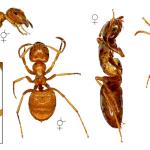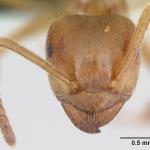Lasius umbratus workers are yellowish and rarely seen due to their underground habits. Unlike the common yellow ant Lasius flavus (Fabricius), L. umbratus workers have numerous erect hairs on their scapes and tibia. Queens are reddish brown and have heads that are broader than the maximum width of the alitrunk. Males are brownish black and have denticulate mandibles.
Throughout British Isles to central Scotland.
It occurs throughout Europe.
This species is not regarded as scarce or threatened.
Can be found in most areas where their host nests exist including open woodland and urban areas. They avoid very dry and very wet habitats.
Mid August to late September.
It nests under boulders, in tree stumps and at the base of old trees. Nests are often carton like structures of thin walled chambers made of fibres and minerals bonded together with secretions and fungal hyphae. New colonies are founded by single queens invading nests of Lasius niger (Linnaeus), L. platythorax Seifert or L. brunneus (Latreille) and possibly L. psammophilus Seifert. In late summer queens are sometimes seen wandering over the surface of a L. niger nest carrying a dead worker as a prelude to securing adoption.
Workers are rarely seen above ground. They forage underground on small invertebrates and tend root-feeding aphids.
2010



